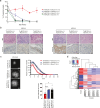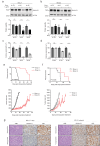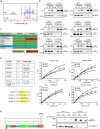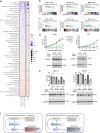The transcriptional co-repressor Runx1t1 is essential for MYCN-driven neuroblastoma tumorigenesis
- PMID: 38992040
- PMCID: PMC11239676
- DOI: 10.1038/s41467-024-49871-0
The transcriptional co-repressor Runx1t1 is essential for MYCN-driven neuroblastoma tumorigenesis
Abstract
MYCN oncogene amplification is frequently observed in aggressive childhood neuroblastoma. Using an unbiased large-scale mutagenesis screen in neuroblastoma-prone transgenic mice, we identify a single germline point mutation in the transcriptional corepressor Runx1t1, which abolishes MYCN-driven tumorigenesis. This loss-of-function mutation disrupts a highly conserved zinc finger domain within Runx1t1. Deletion of one Runx1t1 allele in an independent Runx1t1 knockout mouse model is also sufficient to prevent MYCN-driven neuroblastoma development, and reverse ganglia hyperplasia, a known pre-requisite for tumorigenesis. Silencing RUNX1T1 in human neuroblastoma cells decreases colony formation in vitro, and inhibits tumor growth in vivo. Moreover, RUNX1T1 knockdown inhibits the viability of PAX3-FOXO1 fusion-driven rhabdomyosarcoma and MYC-driven small cell lung cancer cells. Despite the role of Runx1t1 in MYCN-driven tumorigenesis neither gene directly regulates the other. We show RUNX1T1 forms part of a transcriptional LSD1-CoREST3-HDAC repressive complex recruited by HAND2 to enhancer regions to regulate chromatin accessibility and cell-fate pathway genes.
© 2024. The Author(s).
Conflict of interest statement
The authors declare no competing interests.
Figures








References
-
- Shimada H. Tumors of the neuroblastoma group. Pathology. 1993;2:43–59. - PubMed
MeSH terms
Substances
Grants and funding
- APP1016699/Department of Health | National Health and Medical Research Council (NHMRC)
- APP1132608/Department of Health | National Health and Medical Research Council (NHMRC)
- APP1083938/Department of Health | National Health and Medical Research Council (NHMRC)
- IG15182/Associazione Italiana per la Ricerca sul Cancro (Italian Association for Cancer Research)
- IG24341/Associazione Italiana per la Ricerca sul Cancro (Italian Association for Cancer Research)
LinkOut - more resources
Full Text Sources
Medical
Molecular Biology Databases
Research Materials
Miscellaneous

